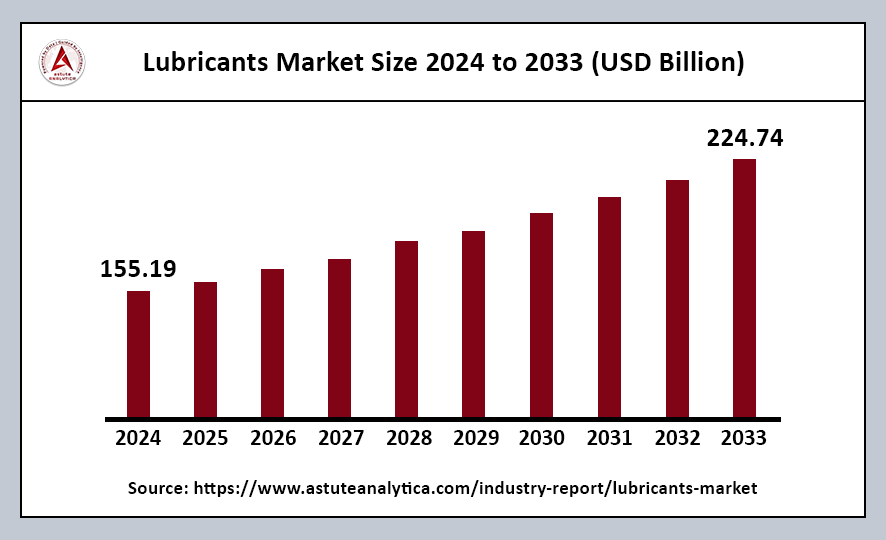The global lubricants market was valued at US$ 155.19 billion in 2024. It is projected to reach a market valuation of US$ 224.74 billion by 2033, reflecting a compound annual growth rate (CAGR) of 4.20% during the forecast period from 2025 to 2033.

The global lubricants landscape has transformed into a multifaceted domain, driven by a wide array of applications that span from automotive and industrial machinery to specialized sectors such as aerospace and marine systems. This evolution reflects the increasing complexity and diversity of machinery and operational requirements across various industries.
Recent sustainability trends and advancements in electric vehicles (EVs) are significantly reshaping lubricant demands. There is a growing emphasis on biodegradable solutions, synthetic formulations, and nano-lubricants. These innovations aim to meet the environmental challenges posed by traditional lubricants while enhancing performance and efficiency.
Lubricants Market Key Takeaways
- By Base Stock, Mineral oil lubricants continue to dominate the global lubricants market, holding over 45% market share.
- By Form, Liquid lubricants anchor a substantial portion of the market, accounting for over 75% of total revenue.
- By Application, Within the market, the automotive industry stands as the largest consumer of lubricants, representing over 45% of the overall share.
- By Product Type, The oil segment maintains a commanding position in the lubricants market, representing over 75% share.
Regional Analysis
Overview of the Asia Pacific Lubricants Market
The Asia Pacific region stands as the largest lubricants market, commanding over 45% market share. This dominance is fueled by a combination of factors, including a massive industrial base, high vehicle production, and rapid urbanization, all of which contribute to the growing demand for lubricants across various sectors.
- Industrial and Automotive Sectors: The region’s dominance in the lubricants market is largely attributed to its strong automotive and manufacturing industries, which are among the major consumers of lubricants. Countries such as China, India, Japan, and South Korea are particularly influential, each making significant contributions to lubricant consumption through their thriving automotive and industrial sectors.
- Vehicle Production: Asia Pacific is home to some of the world’s largest vehicle producers. The high volume of vehicle production in countries like China and India generates substantial demand for various types of lubricants, including engine oils, transmission fluids, and more. This demand is further amplified by the increasing ownership rates and the expansion of the automotive market in these rapidly developing economies.
Revenue Share and Growth Forecast for Europe
In 2024, Europe accounted for a significant revenue share in the lubricants market and is expected to register a considerable Compound Annual Growth Rate (CAGR) over the forecast period. This growth is driven by several factors, including a robust automotive industry and increasing demand for advanced lubricants.
- The Automotive Industry in the European Union: The automotive industry in the European Union (EU) is one of the largest industries globally, constituting a vital component of the region’s economy. It encompasses a wide range of activities, from manufacturing to sales and servicing of vehicles. As a key economic driver, the automotive sector significantly contributes to employment and technological advancement within the EU.
- Production Milestones: In the first three quarters of 2023, the EU produced over 9 million cars, reflecting a 14% increase compared to the same period in the previous year (Q1-Q3). This surge in production highlights the industry’s recovery and growth trajectory post-pandemic, showcasing the region’s resilience and capacity to meet market demands.
- Government Support and Technological Advancements: The European region stands out as one of the world’s leading producers of motor vehicles, largely due to the support provided by governments across various countries. This support often comes from financial assistance and technological harmonization aimed at fostering innovation and efficiency in the automotive sector.
Lubricants Market Segmentation
By Base Stock
Mineral oil lubricants continue to dominate the global lubricants market, holding over 45% market share due to their ready availability, competitive cost, and broad usability. Derived from crude oil, these lubricants are easier to refine and are particularly suitable for industries with large-volume demands. Their stable performance under moderate operating temperatures (below 130°C) allows them to function effectively in engines, industrial machines, and general manufacturing lines.
By Form
Liquid lubricants account for over 75% of total revenue in the lubricants market due to their unmatched adaptability and cooling effectiveness. Unlike greases or dry products, liquid lubricants flow freely into critical clearances, minimizing friction and dispersing heat. These properties are vital in fast-moving components such as bearings, gears, and engines. Liquid lubricants have a broad footprint that spans automotive fleets, industrial tooling, and electricity generation, consistently outperforming other forms of lubrication.
By Application
The automotive industry is the largest consumer in the lubricants market, accounting for over 45% of the overall share. This prominence is driven by significant vehicle production and the essential role of lubricants in engine health. Vehicles, including cars, trucks, and buses—whether passenger or commercial—require multiple types of fluids to operate effectively. These include engine oil, brake fluid, and coolants. The increase in car ownership, particularly in emerging economies, has further elevated lubricant consumption.
By Product Type
The oil segment maintains its commanding position in the lubricants market, representing over 75% market share due to its wide-ranging functions and solid reliability. Oils provide continuous lubrication in high-speed, high-temperature components, including engines, turbines, and gear trains. This lubrication is crucial as it reduces friction and dissipates heat through fluid movement. Oils are flexible enough to serve a variety of applications, from automotive engines to industrial gearboxes, meeting diverse operational needs with fewer complications.
Lubricants Market Recent Developments
- PETRONAS Lubricants International and TVS Racing Partnership: In March 2025, PETRONAS Lubricants International (PLI) reaffirmed its commitment to Indian motorsports by extending its title sponsorship of TVS Racing for another three years. By renewing this collaboration, both companies aim to further elevate the Indian motorsports landscape while strengthening PLI’s presence in the high-performance lubricants market.
- Hindustan Petroleum Corporation and Delhivery Collaboration: In January 2025, Hindustan Petroleum Corporation Ltd (HPCL) partnered with Delhivery to manage the nationwide distribution of its lubricants, HP Lubricants. This collaboration aims to improve HPCL’s supply chain efficiency using Delhivery’s Part Truck Load (PTL) infrastructure and technology.
- Gulf Oil Lubricants and Nayara Energy Partnership: In December 2024, Gulf Oil Lubricants India Ltd. entered a strategic partnership with Nayara Energy to expand its automotive product offerings across India. This collaboration aims to make Gulf’s range of automotive products, including lubricants for two-wheelers, passenger cars, commercial vehicles, and agricultural vehicles, available across this network.
Top Players in Lubricants Market
- ExxonMobil Corporation
- Shell plc
- Chevron Corporation
- BP p.l.c.
- TotalEnergies SE
- Fuchs SE
- Phillips 66
- Indian Oil Corporation
- Amsoil Inc.
- Other Prominent Players
Market Segmentation Overview:
By Base Stock
- Mineral Oil Lubricants
- Synthetic Lubricants
- Bio-based Lubricants
By Form
- Solid Lubricants
- Liquid Lubricants
- Gaseous Lubricants
By Product Type
- Oil
- Greases
- Penetration Lubricants
- Dry Lubricants
By Application
- Automotive
- Industrial
- Marine
- Aviation
- Others
By Distribution Channel
- Online
- Offline
- Direct
- Distributor
By Geography
- North America
- Europe
- Asia-Pacific
- Latin America
- Middle East and Africa
Source: https://www.astuteanalytica.com/industry-report/lubricants-market

















